Content Sections
Adam Smith
Science & communications officer, ANH-Intl
“The reality...is that vaccinology, as portrayed to the public today, amounts to writing religion on the back of ignorance.”
The short version of this review is very simple: this book is brilliant. If you have any interest in the vaccination debate – whether pro- or anti- – we strongly recommend that you invest in it immediately. The reason for our enthusiasm is likewise straightforward. Through painstaking research, the authors have unearthed vital, often long-forgotten data that offers vital answers as to whether vaccines are, or have ever been, “One of the greatest achievements of biomedical science and public health”.
Rather than waste thousands of words going through chapter and verse of Dissolving Illusions, we’ve chosen to repost some of the key graphs and figures provided by the authors in support of their case, with minimal explanatory text. We think you’ll get the picture, if you’ll pardon the pun.
Smallpox: Jenner’s “miracle” exposed
According to the CDC, “In 1796, Edward Jenner inoculated an 8-year-old boy against smallpox and coined the term “vaccination” to describe what he had done. Today, smallpox is a memory thanks to vaccination...” This view is so universal that it has become the ‘founding myth’ of vaccination. And ‘myth’ is, it turns out, entirely the correct word.
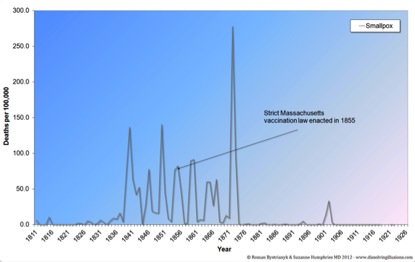
Figure 1. Boston smallpox mortality rate from 1811 to 1926. Taken from Dissolving Illusions by Suzanne Humphries, MD and Roman Bystrianyk [http://www.dissolvingillusions.com/graphs/#2]
As Figure 1 shows, a strict smallpox vaccination schedule in Boston, Massachusetts, USA did nothing to prevent future epidemics; “In fact, more people died from smallpox in the 20 years after the strict compulsory laws than in the 20 years prior”.

Figure 2. England and Wales smallpox and scarlet fever mortality rates from 1838 to 1922. Taken from Dissolving Illusions by Suzanne Humphries, MD and Roman Bystrianyk [http://www.dissolvingillusions.com/graphs/#6]
It was the same picture in the UK, as Figure 2 shows. In the authors’ words, “Smallpox vaccination has always correlated positively to epidemics in the countries that collected data in the vain hope of proving the vaccine’s worth.”

Figure 3. England and Wales smallpox mortality rate vs. smallpox vaccine coverage rates from 1872 to 1922. Taken from Dissolving Illusions by Suzanne Humphries, MD and Roman Bystrianyk [http://www.dissolvingillusions.com/graphs/#7]
And as Figure 3 makes clear, the decline and eventual disappearance of smallpox in the UK had nothing to do with the vaccination rate: smallpox declined even as vaccination coverage dwindled. These demonstrations of the smallpox vaccine’s worthlessness should perhaps be little surprise, given the anecdotal nature of Edward Jenner’s initial experiments. The authors of Dissolving Illusions quote the criticisms of a Dr Creighton: “The only real experiment in the paper on cowpox, as originally offered to the Royal Society, was the inoculation of James Phipps; the results...were recorded with a brevity which enabled Jenner to suppress the true and suggest the false.” Dr Creighton’s thorough and critical analysis of vaccination appeared in full in the Encyclopaedia Britannica in 1890; the crucial graphs had vanished by 1903; and his entry was replaced by 1922 with a new, pro-vaccine piece.
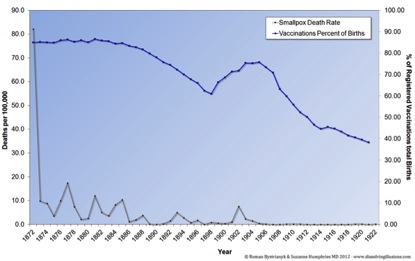
Figure 4. Leicester, England, smallpox mortality rate vs. smallpox vaccination coverage from 1838 to 1910. Taken from Dissolving Illusions by Suzanne Humphries, MD and Roman Bystrianyk [http://www.dissolvingillusions.com/graphs/#8]
Lessons from Leicester
As is increasingly the case today, the public began to get wise to the deficiencies of widespread vaccination. On 23rd March 1885, what became known as the Great Demonstration against compulsory vaccination took place in Leicester, UK. Figure 4 shows that the greatest smallpox epidemic in Leicester coincided exactly with the period of greatest vaccination, and that smallpox deaths declined thereafter even as vaccination rates plummeted.
One important reason for this was implementation of the ‘Leicester Method’: eschewing vaccination for quarantine of smallpox patients and thorough disinfection of their living spaces. “Leicester enjoyed better success against smallpox than other towns in England that were highly vaccinated,” the authors reveal. “In the 1893 smallpox outbreak, the well-vaccinated district of Mold in Flintshire, England, had a death rate about 32 times higher than Leicester.” Flintshire was only one of many such examples. With exquisite irony, a 1972 smallpox outbreak in Yugoslavia was halted through use of the Leicester Method – while the authorities vaccinated 18 million citizens in full knowledge of its ineffectiveness.
Polio, measles and whooping cough
Dissolving Illusions devotes entire chapters to the complex and fascinating histories of vaccination for polio, measles and whooping cough. On polio: “As of today, no programs have been funded to investigate or validate the scientific findings that implicate associations between chemicals like DDT and arsenic and the syndrome of poliomyelitis.”
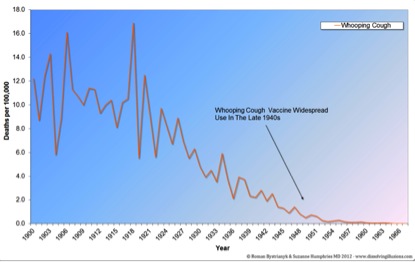
Figure 5. United States whooping cough mortality rate from 1900 to 1957. Taken from Dissolving Illusions by Suzanne Humphries, MD and Roman Bystrianyk [http://www.dissolvingillusions.com/graphs/#14]
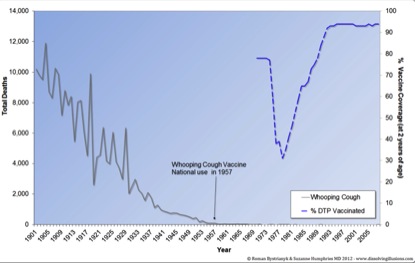
Figure 6. England and Wales whooping cough mortality vs. diphtheria–tetanus–pertussis (DTP) vaccine coverage from 1901 to 2008. Taken from Dissolving Illusions by Suzanne Humphries, MD and Roman Bystrianyk [http://www.dissolvingillusions.com/graphs/#26]
Figures 5 and 6 show that, in both the USA and UK, introduction of a vaccine against whooping cough (pertussis) had a minimal effect, at best, on the mortality rate from the disease. And although the incidence rate, as distinct from mortality, initially appeared to decline, “The paradox is that the incidence...has increased again as the vaccine era has progressed”.
As for measles, “You would never know it today, but the dreaded measles was no longer a major issue in the Western world by the time vaccines were deployed...High measles death rates are still reported in countries where children are undernourished and lack the vitamins and nutrients necessary to support the immune system.” In the UK and USA, however, Figure 7 starkly demonstrates the insignificant effect of measles vaccines on death rates.

Figure 7. Comparison United States and England in mortality rates for measles from 1901 to 1965. Taken from Dissolving Illusions by Suzanne Humphries, MD and Roman Bystrianyk [http://www.dissolvingillusions.com/graphs/#29]
In the USA, a plan initiated in 1963 foresaw eradication of measles by 1967 through widespread vaccination. One shot was thought to be sufficient. A decade later, measles had not been eradicated and two shots were found to be insufficient; “In addition, there is no telling if boosters had much effect past one year”. In 1980, everyone below age 32 was recommended for vaccination, “Because the old vaccines they received were inadequate...Outbreaks of measles continued into the 1990s...there was no perceived problem with the vaccine or the theory of vaccination, but with the people who didn’t get enough injections. As still happens today, the unvaccinated or partially vaccinated were unjustly blamed for the outbreaks occurring in highly vaccinated populations.”
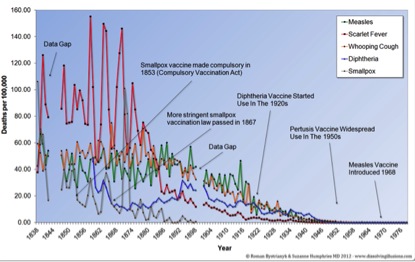
Figure 8. England and Wales mortality rates from various infectious diseases from 1838 to 1978. Taken from Dissolving Illusions by Suzanne Humphries, MD and Roman Bystrianyk [http://www.dissolvingillusions.com/graphs/#11]
Sanitation vs. vaccination
So, if vaccinations weren’t responsible for what the authors dub the “amazing decline” in deaths from infectious diseases in the 19th and 20th centuries (Figure 8) – and they obviously weren’t – then what was? The answer is social change. The 1800s were the age of industrialisation and the attendant boom in urban populations. Men, women and children alike worked backbreaking hours in factories, mines and sweatshops of all stripes. Families were crammed into stinking tenements with no ventilation or running water, where wholly inadequate sanitation left human waste covering the floors. Habitations commonly backed onto open sewers. Disease was an inevitable consequence of such human degradation.
But with the Industrial Revolution came the Sanitation Revolution: “A new understanding that filth contributed to human illness had come to light...projects for the supply of clean water and removal of human and other waste gradually began to be implemented.” The passing of labour laws, the construction of sewerage and clean water systems, along with improved nutritional knowledge and widespread availability of healthy, fresh, clean food, all did their part to allay the fearful toll of preventable diseases. As Dr Thurman Rice acidly observed in 1932, “It is not strange that health improves when the population gives up using diluted sewage as the principle beverage.”
Uncovering history
Dr Humphries and Mr Bystrianyk have done the world an enormous favour by bringing this information back into the light. It could not be more timely, since – just as in the 19th century – authorities worldwide are pressing once more for compulsory vaccination. Before we doom ourselves to repeat our mistakes, we must relearn our tampered history using books like Dissolving Illusions. We must never forget that, as the authors remind us, “Medicine in general, and vaccines even more so, contributed very little to this phenomenal transformation. Regardless, the medical paradigm became the dominant belief, generally displacing all other vastly important human innovations.”
Dissolving Illusions can be purchased at Amazon USA and Amazon UK.







Comments
your voice counts
05 October 2013 at 12:27 am
Looks like a wonderful book, thank you for sharing these graphs!
I hope I can share that Arnica has dozens of local groups across the UK to support Natural Immunity and health choices :)
http://www.arnica.org.uk/
Anna
02 March 2015 at 3:03 am
"Dissolving Illusions can be purchased at Amazon USA and Amazon UK."
True, but please try to get your local bookshop to supply it first!
Your voice counts
We welcome your comments and are very interested in your point of view, but we ask that you keep them relevant to the article, that they be civil and without commercial links. All comments are moderated prior to being published. We reserve the right to edit or not publish comments that we consider abusive or offensive.
There is extra content here from a third party provider. You will be unable to see this content unless you agree to allow Content Cookies. Cookie Preferences